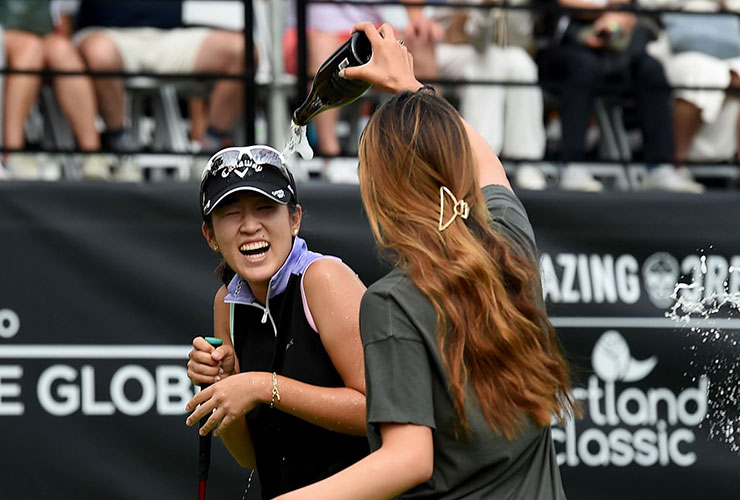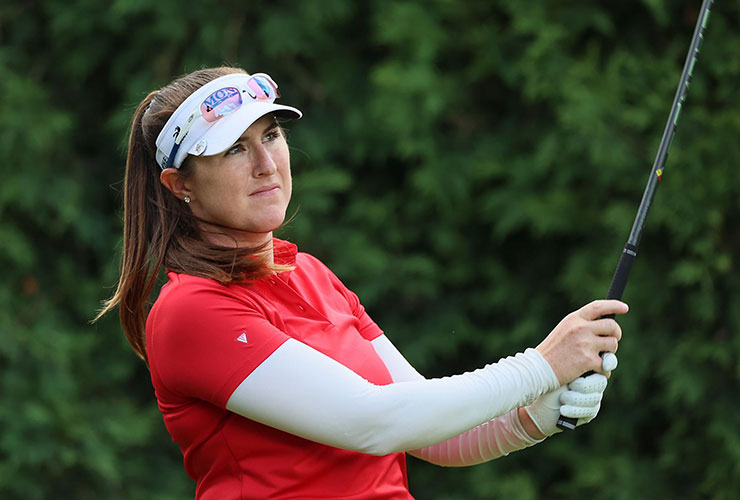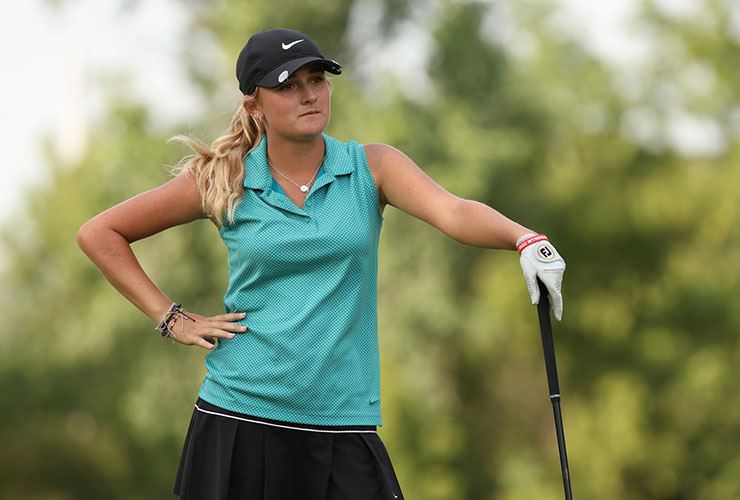Annie Park. LPGA
After two events in Asia, the LPGA Tour returns to the United States this week for the LPGA Drive On Championship in Arizona, and it’s the first full-field event of the season that has a local qualifier. The nervy 18-hole opportunity to earn one of two spots into LPGA events serves as a demanding lifeline to players’ seasons and a chance for a taste of tour life for non-members.
This first local qualifier on Monday at Superstition Mountain in Gold Canyon — the same venue as the Drive On — had a full 48-player field battling to get their seasons under way, and it has a strength of field that rivals regular tour events. Recent major contenders Bianca Pagdanganan and Amy Olson, tour winners Christina Kim, Mi Hyang Lee and Ilhee Lee, and veterans Mariah Stackhouse and Amelia Lewis are signed up.
The group of contenders is so strong that, judging from past results, it will take a low score this week to emerge. From 2018 through 2022, the mean score for the players who advanced from the first tournament’s qualifier was 5.2 strokes under par. That’s nearly three shots better than the average of 2.3 under par in other events over the last 10 years.
For players either trying to re-establish their status or break into the tour for the first time, local qualifying provides a clear but difficult opportunity. Out of the 17 qualifying events over the 2022 season, only two players who got into a tournament through that route ended up inside the top 100 on the Race to the CME Globe points standings: Frida Kinhult and Andrea Lee. And they both missed the cut in the one event at which they locally qualified.
“It’s extremely difficult [to get in through local qualifying],” said Lee, who tried four qualifiers in 2022 and advanced in one. “I knew what I was getting into at the start of last year. I didn’t have practically any status. I finished 109 on CME points in 2021.
“I knew that I’d have to either grind on the LPGA Mondays or get my card through the Epson Tour, and, quite frankly, I thought the latter was what I would have to do in order to get my full status back for the following year.”

Andrea Lee. Steve Dykes
Lee ended up parlaying an early season T-12 finish in the Lotte, where she didn’t have to local qualify, into a breakthrough campaign in which she won the Portland Classic and posted five other top-10s.
One of the best stories from the local qualifying path is Annie Park, who qualified into the 2018 Mediheal Championship for her first start of the season and finished T-18. Two months later, following reshuffling into better status, Park won her first LPGA title at the ShopRite Classic.
Not everyone has Park’s success. Brianna Do tied for 12th at the Lotte last April — the best finish of any local qualifier in 2022 — and reshuffled from near the bottom of the priority list at No. 383 to earning 12 more starts over the rest of the season. But she only made one more cut over the remainder of the year, and she starts 2023 at No. 381.

Amelia Lewis. NurPhoto
Amplifying the importance of the first qualifiers is a chance to play into the Chevron Championship, the tour’s opening major that is set this year for its new home outside of Houston, April 20-23. The LPGA Drive On and LA Open in March, joined by the Lotte Championship in Hawaii in early April, are three tournaments with local qualifying before the cut off.
This year, the LPGA loosened the Chevron’s eligibility requirements. No longer are players required to get into the top 80 of the current year’s CME points to be eligible for the tournament. Instead, it’s going to be top to bottom until 132 players are identified.
Lewis, a 14-year tour veteran, realised in an interview that Hawaii would be the last chance to earn her way into Chevron, and the five-time successful qualifier considered what she’d do if she still needed to make her way into the major.
“As soon as you ask the question, I’m like: ‘Oh, what should I do?’” Lewis said.
After a pause, the Jacksonville native had seemingly made up her mind. “With it counting for Chevron, I think the opportunity is too great to pass up,” she said.
Given the Lotte is played in Hawaii, it has usually attracted fewer players to its qualifier, averaging 25 entrants over the past four years. But that may change this season because it’s scheduled the week before the Chevron. When the now-defunct JTBC Classic in Carlsbad, California, was played immediately in front of the Chevron when it was held in Rancho Mirage, it drew the maximum 48 players the last two seasons.
Capitalising on local qualifying can help a player improve her status on the tour due to the LPGA’s priority list reshuffle, which happens twice each year. It’s a complicated system of numbers crunching, but the bottom line is that the reshuffle is an opportunity to climb to better status.
Given the importance of early local qualifiers to tour members’ prospects for later in the season, the LPGA changed its field-size rules. It placed a cap of up to 48 players, including prioritising LPGA player sign-ups for the week. It’s a notable cut down from the largest fields from 2019 and 2018 of 72 and 70, respectively.
“Part of it was just based on feedback from players wanting to have the local qualifying round on the same course as the tournament course,” Senior Vice President of Tour Operations, Tommy Tangtiphaiboontana, said. “So, having a smaller field on the same tournament course was beneficial in multiple ways.”
Last year, says Tangtiphaiboontana, the LPGA held 12 of its 16 local qualifying rounds on the tournament course, allowing qualifiers to get an experience on the layout while leaving room for players in the field to practise.
The qualifying entry fee is $200 for LPGA and Epson members, and should they advance, that serves as their entry fee for the week. Non-members pay $500. Further, the 48-player field limit is a soft cap, with the tour saying it would not deny an LPGA member getting into a local qualifier.
That new qualifier field-limit cap rarely comes into play farther into the season because after the reshuffles, there’s less incentive for players with still-limited tour status to make an attempt. And that’s where opportunities for non-tour players to get their first taste of the LPGA come in.
“There are definitely events where people know that your odds are better,” said Hannah Gregg, a current Epson Tour player who attempted and did not get through three local qualifiers last year without LPGA status.

Gianna Clemente. Gregory Shamus
Gregg recalled the qualifier at the 2018 Cambia Portland Classic as an example. Merely 11 players participated, with the two qualifying scores being three-over-par 75s. Over the last four seasons, local qualifying in Portland, which is scheduled in late August, averages 18 players.
Indeed, it is no surprise that recent successes of non-tour members occur during the latter part of the season. In 2015, Brooke Henderson local qualified in Portland with a score of four-under par and went on to win — the only player in LPGA history to do so. Four years later at the same event, Yealimi Noh qualified out of a field of 19. She then finished runner-up to Hannah Green.
There was one remarkable local qualifier story last season. Gianna Clemente, a 14-year-old amateur, used the path to reach three consecutive tournaments last season (CP Women’s Open, Dana Open, and Kroger Queen City Championship). Clemente became only the second player to pull off the feat three straight times.
“It was cool to be in all three, much less to qualify into all three,” Clemente told the LPGA’s website at the time. She wasn’t able to make the cut in any of the events.
The allure for non-members is in the substantial LPGA purse compared to mini-tours. The biggest purse on the Women’s All Pro Tour, the qualifying circuit of the Epson Tour, is $100,000. Epson’s largest is $335,000. The Portland Classic is the smallest LPGA purse with local qualifying at $1.5 million.
“Monday into an LPGA event comes with the opportunity to make the cut,” Gregg said, “and make some serious money that can carry you for a good chunk of the rest of your season.”
Regardless of the player’s membership status, the local qualifiers provide crucial feedback on how close players are to their LPGA dreams.
“I’ve actually come to enjoy qualifiers because yes, it’s one day, one shot, one round to qualify for the LPGA event,” Lewis said. “So it’s kind of a ‘go big or go home’ mentality, and you really get to test your game and see where it’s at. You can’t play it safe, and I really like that.”









